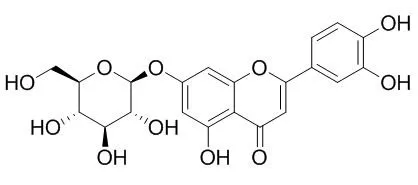| Kinase Assay: |
| Biol Pharm Bull. 2011;34(7):1032-6. | | Luteolin-7-O-glucoside suppresses leukotriene C(4) production and degranulation by inhibiting the phosphorylation of mitogen activated protein kinases and phospholipase Cγ1 in activated mouse bone marrow-derived mast cells.[Pubmed: 21720009] |
METHODS AND RESULTS:
In this study, Luteolin-7-O-glucoside (L7G), an herbal medicine isolated from Ailanthus altissima, inhibited 5-lipoxygenase (5-LOX)-dependent leukotriene C(4) (LTC(4)) production in bone marrow-derived mast cells (BMMCs) in a concentration-dependent manner with an IC(50) of 3.0 μM. To determine the action mechanism of L7G, we performed immunoblotting for cytosolic phospholipase A(2) (cPLA(2)) and mitogen-activated protein kinases (MAPKs) following c-kit ligand (KL)-induced activation of BMMCs with or without L7G. Inhibition of LTC(4) production by L7G was accompanied by a decrease in cPLA(2) phosphorylation, which occurred via the extracellular signal-regulated protein kinase-1/2 (ERK1/2) and p38 and c-Jun N-terminal kinase (JNK) pathways. In addition, L7G also attenuated mast cell degranulation in a dose-dependent manner (IC(50), 22.8 μM) through inhibition of phospholipase Cγ1 (PLCγ1) phosphorylation.
CONCLUSIONS:
Our results suggest that the anti-asthmatic activity of L7G may be mediated in part via the inhibition of LTC(4) generation and mast cell degranulation. |
|
| Cell Research: |
| Food Chem Toxicol. 2014 Mar;65:70-5. | | Luteolin and luteolin-7-O-glucoside strengthen antioxidative potential through the modulation of Nrf2/MAPK mediated HO-1 signaling cascade in RAW 264.7 cells.[Pubmed: 24361407] | It has been understood that glycosidic forms of flavonoids were hydrolyzed by gut bacteria and absorbed as aglycones. However, several reports suggested that glycosides were partly absorbed without hydrolysis and remained biologically active.
METHODS AND RESULTS:
In this study, we evaluated the antioxidative potential of luteolin and Luteolin-7-O-glucoside, glycosidic form of luteolin, against the oxidative damage and compared their antioxidative mechanisms in RAW 264.7 cells. Heme oxygenase-1 (HO-1), one of the phase II enzymes showing an antioxidative activity, was potently induced by luteolin and Luteolin-7-O-glucoside treatment, which was in accordance with the translocated nuclear factor-erythroid 2 p45-related factor 2 (Nrf2) into nucleus. Moreover, luteolin and the Luteolin-7-O-glucoside activated HO-1 expression by p38 and c-Jun NH2-terminal kinase (JNK) regulation. In order to identify the antioxidation potential by HO-1, tert-butyl hydroperoxide (t-BHP)-induced oxidative damage was applied and ameliorated by luteolin and the Luteolin-7-O-glucoside treatment in a dose dependent manner, which was confirmed by HO-1 selective inhibitor and inducer, tin protoporphyrin (SnPP) and cobalt protoporphyrin (CoPP), respectively.
CONCLUSIONS:
Consequently, luteolin and Luteolin-7-O-glucoside potently strengthen the HO-1-mediated antioxidative potential through the modulation of the Nrf2/MAPK signaling pathways. | | Nutr Res Pract. 2013 Dec;7(6):423-9. | | Luteolin and luteolin-7-O-glucoside inhibit lipopolysaccharide-induced inflammatory responses through modulation of NF-κB/AP-1/PI3K-Akt signaling cascades in RAW 264.7 cells.[Pubmed: 24353826] | Luteolin is a flavonoid found in abundance in celery, green pepper, and dandelions. Previous studies have shown that luteolin is an anti-inflammatory and anti-oxidative agent.
METHODS AND RESULTS:
In this study, the anti-inflammatory capacity of luteolin and one of its glycosidic forms, Luteolin-7-O-glucoside, were compared and their molecular mechanisms of action were analyzed. In lipopolysaccharide (LPS)-activated RAW 264.7 cells, luteolin more potently inhibited the production of nitric oxide (NO) and prostaglandin E2 as well as the expression of their corresponding enzymes (inducible NO synthase (iNOS) and cyclooxygenase-2 (COX-2) than Luteolin-7-O-glucoside. The molecular mechanisms underlying these effects were investigated to determine whether the inflammatory response was related to the transcription factors, nuclear factor (NF)-κB and activator protein (AP)-1, or their upstream signaling molecules, mitogen-activated protein kinases (MAPKs) and phosphoinositide 3-kinase (PI3K). Luteolin attenuated the activation of both transcription factors, NF-κB and AP-1, while Luteolin-7-O-glucoside only impeded NF-κB activation. However, both flavonoids inhibited Akt phosphorylation in a dose-dependent manner.
CONCLUSIONS:
Consequently, luteolin more potently ameliorated LPS-induced inflammation than Luteolin-7-O-glucoside, which might be attributed to the differentially activated NF-κB/AP-1/PI3K-Akt pathway in RAW 264.7 cells. |
|






 Cell. 2018 Jan 11;172(1-2):249-261.e12. doi: 10.1016/j.cell.2017.12.019.IF=36.216(2019)
Cell. 2018 Jan 11;172(1-2):249-261.e12. doi: 10.1016/j.cell.2017.12.019.IF=36.216(2019) Cell Metab. 2020 Mar 3;31(3):534-548.e5. doi: 10.1016/j.cmet.2020.01.002.IF=22.415(2019)
Cell Metab. 2020 Mar 3;31(3):534-548.e5. doi: 10.1016/j.cmet.2020.01.002.IF=22.415(2019) Mol Cell. 2017 Nov 16;68(4):673-685.e6. doi: 10.1016/j.molcel.2017.10.022.IF=14.548(2019)
Mol Cell. 2017 Nov 16;68(4):673-685.e6. doi: 10.1016/j.molcel.2017.10.022.IF=14.548(2019)